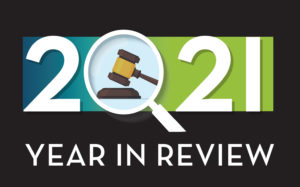2021: The Year in Review
Posted
December 22, 2021
Share:
Much like the year that preceded it, 2021 saw a continuation of the sweeping changes to law enforcement tactics, procedures, and reporting brought about by state-level reform legislation. In the absence of legislation at the federal level, state legislatures continued to pursue changes to use of force policies, more rigorous certification reporting standards, and newly established duty to report requirements. Though states have taken varied approaches to reform and modernizing their law enforcement agencies, the legislations’ goals and themes are broadly consistent – to increase the effectiveness and consistency of law enforcement by improving community trust and making strides towards greater transparency. With that in mind, we look back on another busy year in law enforcement legislation.
2021 By the Numbers
 Of some 2,670 bills introduced into state legislatures across the country, 366 were enacted into law. Most, but not all, of these pieces of legislation are a part of broad reform efforts that began in 2020 in the wake of several high-profile incidents involving law enforcement.
Of some 2,670 bills introduced into state legislatures across the country, 366 were enacted into law. Most, but not all, of these pieces of legislation are a part of broad reform efforts that began in 2020 in the wake of several high-profile incidents involving law enforcement.
Forty-three pieces of legislation covered certification and decertification of officers. Though many of these bills were relatively routine updates to certification standards, there was a notable trend in reform-oriented bills designed to increase transparency in hiring and certification. Legislation like Colorado’s HB21-1250 aims to close perceived loopholes in reporting complaints against an officer. Many of these new laws call for increased information and data sharing among agencies and POST organizations.
Law enforcement training was addressed in 59 bills, with many of the pieces of legislation requiring (and funding) enhanced training for officers. Mental health awareness was a noteworthy aspect of many of these new training requirements, with seven states mandating training designed to help law enforcement officers recognize and respond to individuals experiencing mental health crises.
It is well understood policing can be a challenging profession even in the best of times. The health and wellness of law enforcement officers have been a vital concern of policymakers across the country, undoubtedly owing to the increased demands on agencies and officers. A total of 24 states enacted 47 bills that provide funding for comprehensive programs addressing trauma and PTSD that affect first responders by providing crisis counseling and trauma-informed mental health services to agencies.
In 2021, 30 bills enacted into law tackled data, data security, and oversight. A common theme was standardizing the data collected and reported by state POST organizations regarding officer certification and training. New laws like Oregon’s HB 2932 called for creating databases to capture information on use of force incidents for public review and participation in the National Use-of-Force Collection initiative led by the FBI.
Narrowing our focus, we’ll take a closer look at three themes commonly seen in state-level reform legislation. Though the following list is not exhaustive, it represents some of the most notable new legislation of 2021.
Use of Force
Incidents related to policing and use of force in 2020 were a significant driver of reform-oriented legislation carrying into 2021. Before this, a patchwork of often ill-defined laws and local restrictions governed use of force. After substantial public debate and commentary, several states passed sweeping legislation clarifying use of force policy and creating new guidelines on when force can be applied, what kind of force is used, and how it is reported.
The state of Delaware approved significant changes to use of force policies that were previously loosely defined. In 2021 the state established a “reasonableness” standard for instances involving use of force involving law enforcement. Going a step further, many states addressed the specific issue of chokeholds in 2021 law enforcement legislation. Indiana, for example, restricted the use of holds that place pressure on the neck and now defines them as a form of deadly force with the passage of HB 1006. In contrast, the California legislature passed AB 490, which forbids the use of “carotid restraint” with no exceptions for deadly force. In addition to California, eight other states have banned chokeholds entirely, limiting their use to incidents where deadly force would otherwise be justified.
Centralized Reporting
To confront so-called “wandering officers” who leave a department due to misconduct allegations only to seek employment at other agencies, many state legislatures have addressed the need to create more robust systems to track officer certification at the state level. By monitoring and reporting issues with officer certification, the hope is that officers showing patterns of misconduct complaints will be prevented from resuming employment at another agency. Arkansas, Illinois, Indiana, Utah, and Washington, among others, set up new requirements concerning reporting officer resignations, terminations, or misconduct.
A National Decertification Index is maintained by the International Association of Directors of Law Enforcement Standards and Training (IADLEST). While the database does not preclude anyone from employment as a law enforcement officer, it serves as a national registry for certification revocations that come about as the result of officer misconduct. In 2021, Indiana and Washington joined Massachusetts in reporting to this voluntary database.
Duty to intervene
To further reduce the use of unnecessary force, four states created varying regulations requiring fellow officers to intervene in incidents involving excessive force or official misconduct. In addition to curbing the use of excessive force, these policies aim to strengthen community trust in law enforcement through increased transparency, improve officer safety by ensuring proper procedures are being followed, and diminish the effect of a “code of silence” that permits unlawful or unethical behavior to persist.
Of these four states creating a duty to intervene, three have also enacted an obligation to report misconduct or excessive force to superiors. While there is some variation in the definitions of excessive, prohibited, unreasonable, and unauthorized force, the underlying motivation in preventing unwarranted force incidents remains the same. Five of these states’ new laws do not mandate any specific sanctions for a failure to report, while several others call for discretionary action, usually through Internal Affairs or other agency-specific procedures. For example, Washington created one of the more comprehensive duty-to-intervene laws requiring that officers found to violate these policies face mandatory decertification. In California, a new law creates specific protections for officers that report potential misconduct related to use of force.
Later this month, we’ll be looking forward, exploring how these trends will continue to evolve in 2022.
References:
https://www.brennancenter.org/our-work/research-reports/state-policing-reforms-george-floyds-murder
https://www.ncsl.org/research/civil-and-criminal-justice/legislative-responses-for-policing.aspx
Related Posts
Ready to Experience the Benchmark Difference?
Benchmark Analytics and its powerful suite of solutions can help you turn your agency’s challenges into opportunities. Get in touch with our expert team today.



